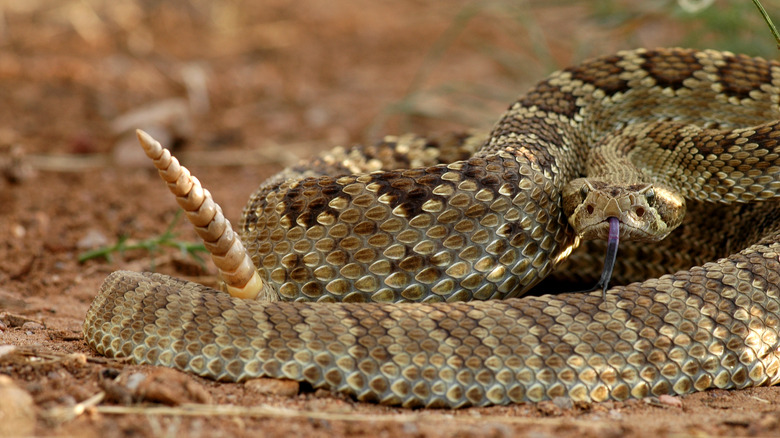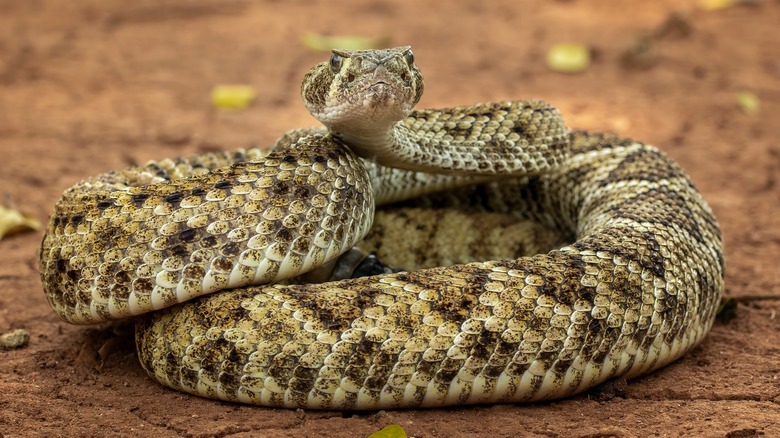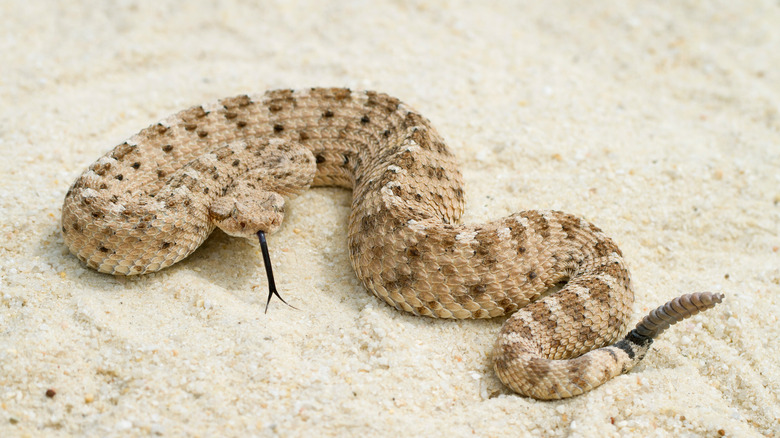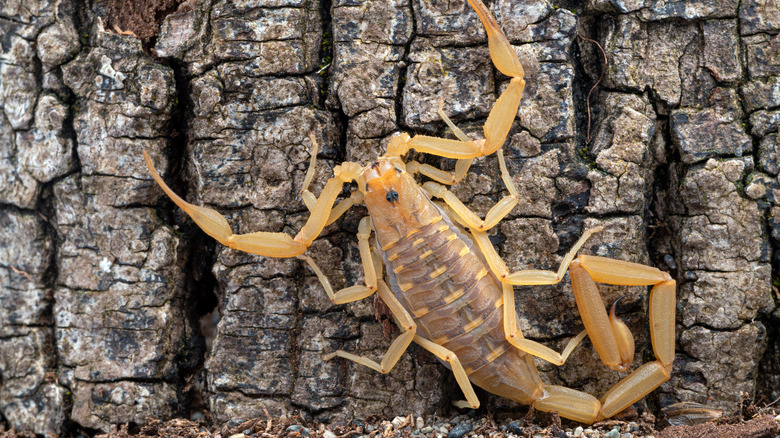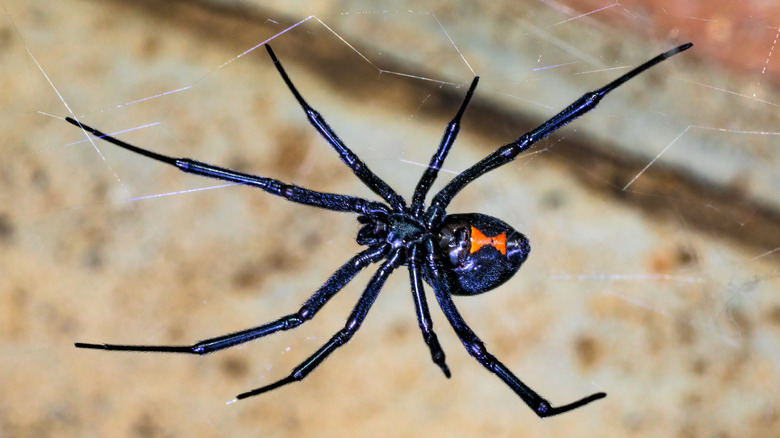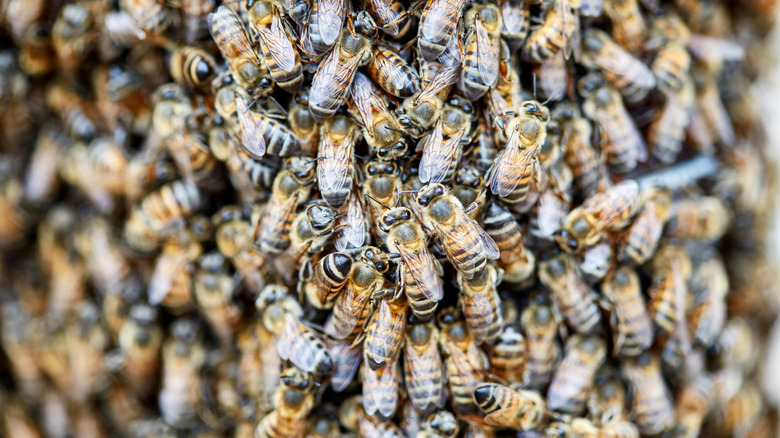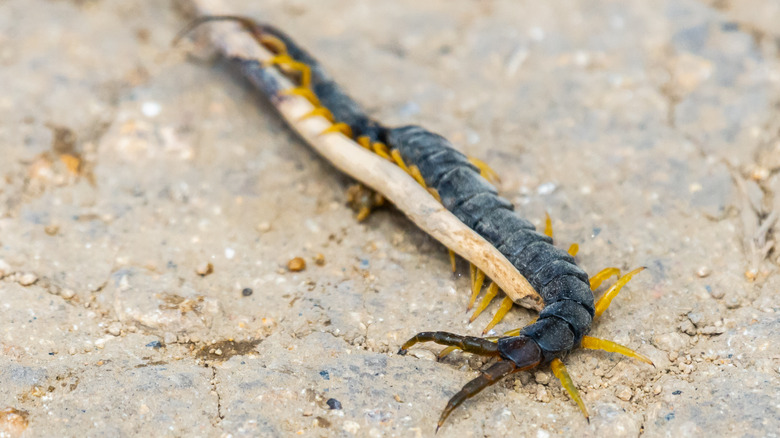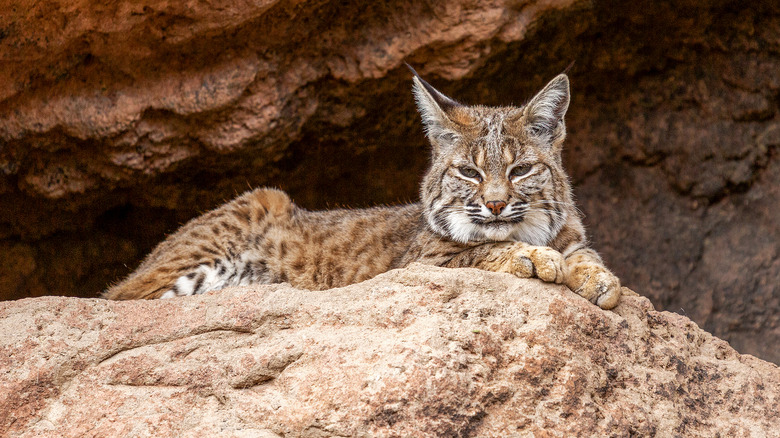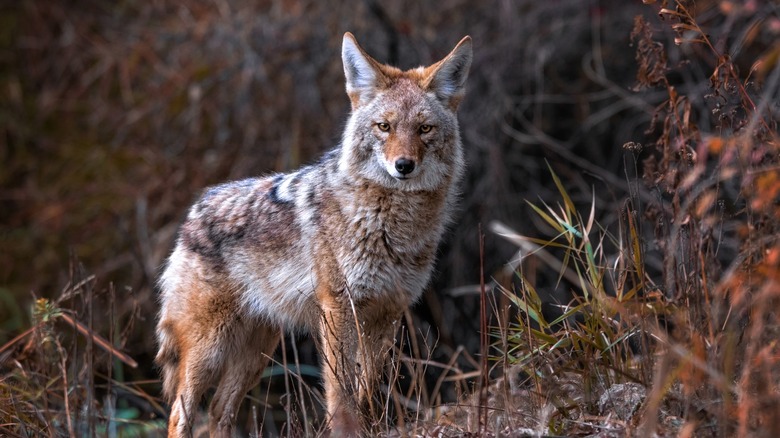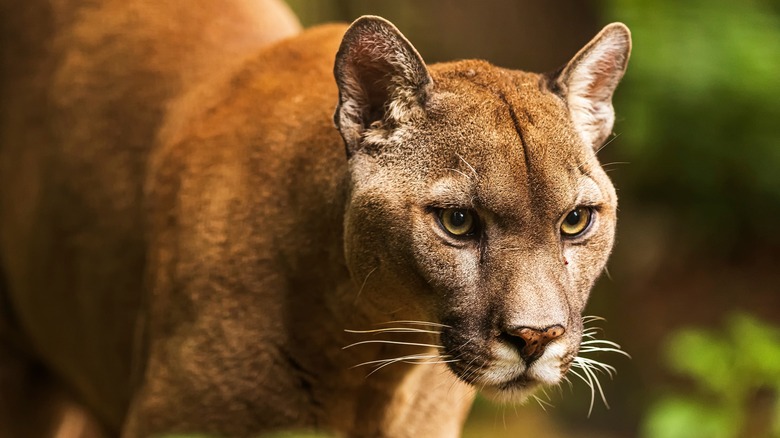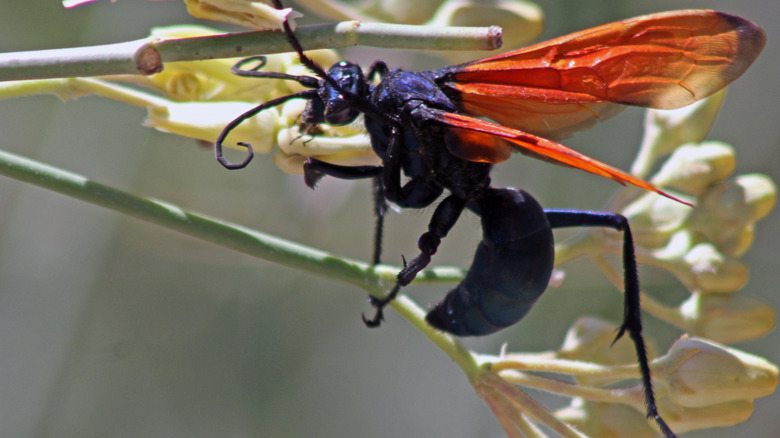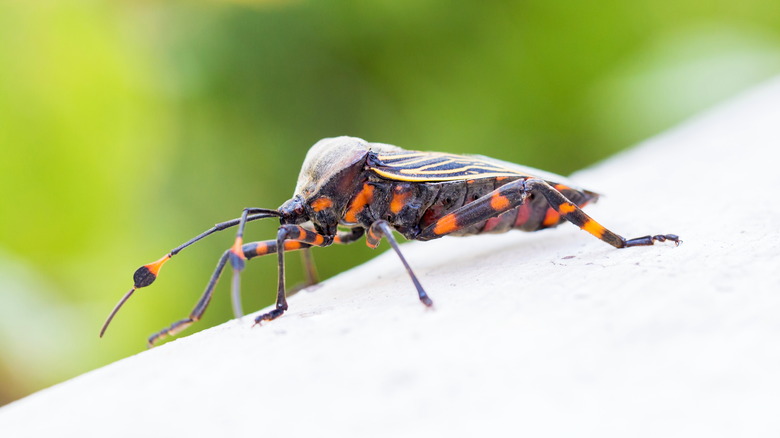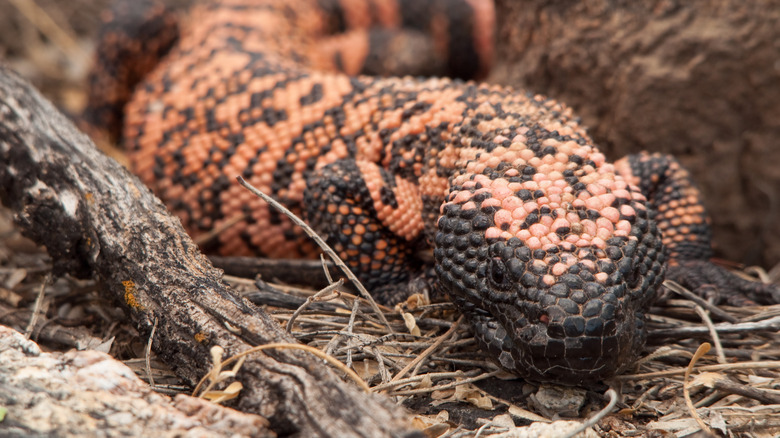13 Creatures To Beware Of When Adventuring In California's Deserts
In a state as large as California, you are going to encounter diverse ecosystems. From the dramatic Pacific coastline, the fertile vineyards of Sonoma, the jaw dropping size of the Redwood Forest, and the breathtaking beauty of Yosemite, California is not short on amazing places. However, it's California's desert that has always maintained a certain level of mysticism and danger. Nowhere are these traits captured more purely than in the dangerous creatures that roam it.
California has three major deserts: the Mojave, Colorado, and Great Basin. In these deserts live some of the most dangerous, rare, and lethal creatures in all of North America. Some are large and common to our eyes, but don't let size deceive you. Creatures don't need to be large and powerful in order to be dangerous. In fact, some of the ones you will find on this list are not much bigger than a penny, and all the more dangerous because of it.
Now, we're not saying that the second you start exploring the California desert that you will be set upon by these creatures. However, you need to know what they are, what they look like, and what they can do to you if you're not careful. So, keep your wits about you and exercise common sense whenever you encounter one of these 13 creatures to beware of when adventuring in California's deserts.
Mojave Green Rattlesnake
The Mojave Green (Crotalus scutulatus) is the most venomous snake found in the Mojave Desert in southern California. They are easily identified by the green hue on their diamond patterned scales, and can grow anywhere from 2 feet to 4.5 feet long. Though they live across the state, they have a preference for the dry, hot conditions of the desert. During the day, they hide beneath rocks or shrubs to avoid the sun. They are most active between April and September during the cool hours of the evening.
The Mojave Green has a particularly dangerous bite that, if not treated immediately, can be fatal. Apart from the actual physical pain of the bite, Mojave Green has specific neurotoxins that can wreak havoc on the body's nervous system. If that weren't enough, their venom also contains hemotoxins which directly attack the bloodstream. Such fun, no?
If you or one of your hiking partners is bitten by a Mojave Green call 9-1-1 and seek medical attention immediately. En route to treatment, keep the affected area below heart level so the toxins do not flow down to the heart, and do not try to put a tourniquet on the area as the restricted blood flow will lead to amputation. Prepare accordingly by wearing long pants or thick socks with boots that reach up around your ankles. Avoid underbrush whenever possible and never, under any circumstances, approach a snake, even if it appears deceased.
Western Diamond-Back Rattlesnake
The second spot on our list goes to the Western Diamond-Back Rattlesnake (Crotalus atrox). These highly venomous snakes are characterized by their triangular heads, heavy bodies, and diamond-shaped scale pattern. They can be confused for their cousin, the Mojave Green, only the Diamond-Back has a much more pronounced pattern and a sandy-brown color to its scales. It also has two long, triangular lines running from its eye sockets to its jaw. These snakes have been known to reach 7 feet in length.
Though they typically feed on rodents and lizards, Diamond-Backs have been known to bite humans. Like the Mojave Green, they have toxins in their venom that attack the nervous system. Though not as venomous, the same steps should be taken to avoid and treat a Diamond-Back bite as a Mojave Green bite. Failure to heed the warning rattle or threatening hisses can result in severe pain, muscle and tissue damage, and even death.
As before, do not approach these snakes under any circumstances. Avoid burrows during the wintertime, as this is when all rattlesnakes are looking for mates and can be particularly aggressive when danger is sensed.
Sidewinder Rattlesnake
Third, but not least, on the Snakes to Avoid list is the Sidewinder Rattlesnake (Crotalus cerastes). A particularly mean looking snake, the Sidewinder has also been called the Horned Rattlesnake on account of the horn-shaped scales that creep up along the eye sockets. All rattlesnakes are what are known as pit vipers, meaning that they have visible pits in their heads which detect the heat signatures of their prey. It also means they are extremely venomous.
We won't go into too much detail about the venomous component of this snake. Know that the bite effects and medical procedures are basically the same as the previous two snakes. Though their bites are seldom fatal, they still are dangerous snakes whose presence in the desert is not to be taken lightly.
Though their horns are easily the most physical identifier of this snake, you will also be able to know if one is lurking nearby by the slithering pattern it leaves in the sand. The reason it bears the nickname sidewinder is because their specific style of movement leaves a J-shaped trail. Unlike the other snakes, which slither forward, the Sidewinder loops itself and stretches forward, meaning that its body is never fully in contact with the ground. It can move at speeds of up to 18 mph.
Bark Scorpion
There is no word better suited to this particular scorpion than "creepy". The Bark Scorpion, more specifically the Arizona Bark Scorpion (centruroides sculpturatus) is typically found crawling on logs. These hair-raising arthropods are the most venomous of their kind in the United States, and are considered deadly.. Found in the southern deserts of California, the Bark Scorpion actually has a tan colored shell, with a distinctly dark shade running along its abdomen. They have two large pincers up front, and a stinging tail that loops upwards in a threatening arch.
Though only four fatalities resulting from bark scorpion stings have been reported over the last decade, you should still consider them a serious threat when out in the wilderness. The good news is that you aren't likely to run into them during the day. They are nocturnal hunters and prefer the shade of logs, shrubs, rocks, and even the walls of a house. Cause for caution would be approaching a log, or hiking in the desert at night, which is never advisable.
These scorpions have a wide habitat range and can be found in all three of California's major deserts. If you do happen to get stung, you can expect lots of swelling pain at the sting sight, nausea, shortness of breath, and, in some cases, paralysis or death. Most scorpion stings are accidental, and they are not likely to harm you if you come across one. We would not, however, recommend approaching it.
Black Widow Spider
If you're thinking of a venomous spider, you're very likely thinking about a Black Widow (Latrodectus hesperus). Perhaps the most notorious spider in the world, Black Widows are not to be trifled with. You can identify one very easily. They are eight legged, jet black, and have a blood red hourglass shape on their abdomen. Found in the warmer climates of the United States, the black widow spider proliferates California's deserts and should not be crossed under any circumstances.
They can be found in a number of different locations, such as logs, shrubs, chairs, benches, and fences. Their bite is highly venomous, containing toxins that are known to make healthy adults severely ill, and can even kill children and the immunocompromised elderly. You might not know you've been bitten by one, as the bite is similar in pain to a pinch. Shortly after, however, heavier pain will spread to your chest or abdomen, and there will be redness and swelling at the bite site. Further symptoms include nausea, vomiting, numbness, sweating, muscle weakness, and potential seizures. All from a spider not much bigger than the tip of your index finger.
So, be cautious when you encounter places that seem to cater for spider habitats. You are not likely to have too much of a problem unless the spider feels threatened. However, females can be particularly aggressive. Part of their name comes from the fact that they devour the males after mating.
Killer Bees
Another example of the small but dangerous critter is the Killer Bee, also known as the Africanized Honey Bee (Apis mellifera scutellata). These honey bees are considered such a danger that residents are encouraged to call Animal Control if the population grows too vast. Like other honey bees, Africanized honey bees do not attack unless they are provoked. Unlike other honey bees, however, they react far more swiftly and in far greater numbers.
When an Africanized honey bees colony is provoked, the entire colony will come after the aggressor. They have been known to chase humans up to a quarter-of-a-mile. So, if you come across a hive in the desert and invoke their wrath, we hope you're a champion runner. Africanized honey bees will swarm and attack the foe with a ferocity unmatched in the bee kingdom. It is not uncommon for an Africanized honey bees to sting upwards of 10 times more than a European honey bee. If a swarm averages a few hundred bees, and you're looking at the potential of thousands of stings.
Now, these can be fatal to practically everyone if not treated immediately. However, those with bee sting allergies should exercise extreme caution when venturing anywhere near a nest. Get too close, and you will be sorry you ever approached. These bees are considered a highly invasive species and are prolific throughout southern California's deserts.
Common Desert Centipede
Another creature that puts the creepy in creepy crawly, the Common Desert Centipede (Scolopendra heros) is the kind of arthropod you just don't want to cross. Apart from the fact that they're downright terrifying, from their enormous size to their flat, segmented body, their black and mucus orange color, the pincers on the desert centipede cause a bite that is one of the most painful that can be experienced.
These centipedes are most commonly found crawling along the desert floor at night. They avoid the heat of the day by living under rocks, where they wait and lurk for other prey such as insects and even small rodents. If you do happen to overturn a rock and get bit by one of these centipedes, be prepared for a world of pain. Though the bite is not likely to kill you, it will send you to the ER for treatment in a hurry. The venom from the bite will spread and cause more pain, and potentially some nerve damage, if not treated immediately.
Gloves and other tools that protect your hands are a great way of preventing accidental bites. You should certainly not intentionally provoke these centipedes, lest you're jonesing for a hospital visit and the embarrassing explanation to the doctor that you got bit because you teased a centipede.
Bobcat
Now we're getting into some of the bigger and more recognizably dangerous animals wandering the California deserts. The Bobcat (Lynx rufus) is a native cat of California. Though they are not very common to sight in the wild owing to their elusive nature, you should still be wary of their presence. Bobcats are defined by their large, tufty ears, a bobbed tail, and mostly gray fur with mild, dark markings. Usually most active around dawn and sunset, you're most likely to encounter these cats, or be very near one, if you're trying to catch the sunrise or sunset.
Here is the thing you need to be aware of. Bobcats will not attack a human, unless it is acting in defense of itself, and especially its kittens. If you happen across a stray kitten while you're out hiking, leave it alone. The mother is likely closer than you think, and could give you a decent mauling if you attempt to touch her kitten. Bobcats won't kill you, but their large teeth and claws certainly have the potential to send you to the hospital.
Of all the creatures on this list, the bobcat is one you really don't need to be too concerned about. So long as you know that they are there even if you can't see them and you're not silly enough to try and provoke one to attack, you're in the clear with these clever cats.
Coyote
Probably the most common of all wild, predatory dogs in the United States, Coyotes (Canis latrans) inhabit California by the hundreds of thousands. Distinguished by their yelp and their coat of light gray fur tinged with red, coyotes are among the most intelligent, and adaptable of all wild canines. They're particularly well adapted to urbanized areas, which can be something of a problem.
As California is one of the most developed states in the entire country, a fair amount of bare desert has given way to suburban and urban environments. Los Angeles and San Diego are perfect examples. So, it is not entirely uncommon to be taking a morning walk in your neighborhood and come across one or several coyotes rifling through garbage or attempting to attack domestic livestock like dogs, cats, and chickens.
While they have been known to attack people, most coyotes will leave when startled. However, the more they become accustomed to being around people, the less likely they are to act on their natural fear. So, you're probably not going to be as bothered by a coyote when hiking in the high desert as you are trying to keep one away from your dog. Act cautiously, because coyotes are known carriers of rabies.
Mountain Lion
The second of California's big cats is the Mountain Lion (Puma concolor). A protected class of feline, these enormous cats are long and muscular, with a tan coat of short fur. Highly elusive, more and more sightings have been reported in California over the last several years thanks to the presence of home security cameras, trail cameras, and wildlife control social media accounts. Mountain lions live in a variety of different habitats across California, but the rocky terrain of the desert mountains are a particular favorite.
Like the bobcat, mountain lions are not in the habit of attacking humans out of the blue. We are not on their list of animals to prey upon, so they don't typically go after us. That does not mean, however, that the danger is not present, especially when you're out in the wild. Never, under any circumstances, provoke a mountain lion or go anywhere near her cubs. You're not defenseless by any means. Bear spray is a particularly good repellent. But between a cat that is virtually all muscle, has large claws, and sharp teeth, it's not an even match.
So, while the encounters between mountain lions and humans are rare, being cautious and knowing what not to do is only going to be a benefit to you. Getting mauled by a mountain lion is not something anyone should ever hope to experience.
Tarantula Hawk
It's not a bird. It's an enormous wasp. The Tarantula Hawk (Pepsis) is part of the family of spider wasps which specifically go after tarantulas. They don't eat tarantulas, however. Oh no, what happens to the spider is the stuff of nightmares. The sting paralyzes the spider, allowing the Wasp to drag it back to its nest and implant eggs inside of the tarantula. The poor spider is then consumed from the inside out by the wasp larvae, who emerge from the spider when fully grown. Once they leave the carcass their carnivorous appetite switches to pollen, unless they're hunting down another spider to serve as host for eggs.
While Tarantula Hawks generally leaves people alone, they have the most painful wasp sting in the entire world. Seeing as it paralyzes a tarantula, how could it not be? The stinger on these huge wasps extends from the back of its jet black abdomen, and can sometimes be as long as a ¼ of an inch. The unrelenting pain caused by a sting can last upwards of five minutes. It does not cause any lasting damage that we know of, but you're in for one heck of a few minutes if you do anything to spook or provoke these wasps.
You can find them sprinkled throughout the desert, feeding off of the pollen of shrubs and flowers. If you do happen to come across one dragging a tarantula to its lair, be happy you're a vertebrate and continue onwards.
Kissing Bugs
Kissing Bugs (Triatominae) are pests in the extreme. Though they are no larger than a penny, these blood sucking insects are actually one of the leading causes of Chagas disease in the United States. Though they are not overly common in California, they nevertheless persist in warmer climates and are particularly fond of rural desert areas, of which California has several.
Kissing bugs can pick up the parasite that causes Chagas disease through sucking on the blood of a contaminated host. The parasite is then transported between hosts through the feces of the kissing bug, which often poop when feeding. If a person scratches away a kissing bug, they could be scraping the feces directly into the wound. This is why it's important to bring bug spray and protect against insect bites by wearing longer clothes and bug screen hats in areas where they are particularly prolific.
Chagas disease has both an acute and chronic phase. The acute phase can cause fatigue, fever, and overall flu-like symptoms. Once the chronic stage develops, however, there can be potentially significant heart issues. While the odds of getting Chagas disease from kissing bug are 1 in 3, it's still a good idea to try and keep these critters from getting at you (via Texas Ecological Laboratory).
Gila Monster
Last, but certainly not least on this list is the Gila Monster (Heloderma suspectum). Rare in the extreme, Gila Monsters nevertheless occupy certain territories in the southern California desert. These large lizards are defined by their black and orange mottled scales and their dark purple mouths. The scales on this lizard are particularly noteworthy owing to their bead-like appearance and striking colors. They love the deep desert and are found crawling across the desert floor in search of prey.
Here's why you should be wary of them, rare though they may be: they have an incredibly venomous bite. Though it is not known to be fatal to humans, it can nevertheless cause severe pain and illness, such as swelling, vomiting, increased heart rate, dizziness, and weakness in the limbs. An ER visit will be required if a bite happens, though it is highly unlikely. Still, one should be prepared for all possibilities.
The fact that these creatures exist should not, in any way, stop you from going to California. It is a beautiful state with abundant opportunities for adventure. So long as you take the proper precautions and use some common wilderness sense, there is no reason why any of these creatures should harm you.

